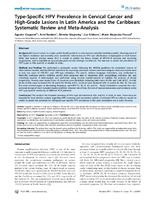Please use this identifier to cite or link to this item:
http://sgc.anlis.gob.ar/handle/123456789/398| Title: | Type-Specific HPV Prevalence in Cervical Cancer and High-Grade Lesions in Latin America and the Caribbean: Systematic Review and Meta-Analysis | Authors: | Ciapponi, Agustin Bardach, Ariel Glujovsky, Demian Gibbons, Luz Picconi, María Alejandra |
Keywords: | Neoplasias;Neoplasias del Cuello Uterino;Infecciones por Papillomavirus;América Latina;Región del Caribe | Issue Date: | 2011 | Publisher: | Yes | Journal: | Plos one | Abstract: | Background: Cervical cancer is a major public health problem in Latin America and the Caribbean (LA&C), showing some of the highest incidence and mortality rates worldwide. Information on HPV type distribution in high-grade cervical lesions (HSIL) and invasive cervical cancer (ICC) is crucial to predict the future impact of HPV16/18 vaccines and screening programmes, and to establish an appropriate post-vaccinal virologic surveillance. The aim was to assess the prevalence of HPV types in HSIL and ICC in studies in LA&C. Methods and Findings: We performed a systematic review, following the MOOSE guidelines for systematic reviews of observational studies, and the PRISMA statement for reporting systematic reviews and meta-analyses. Inclusion criteria were at least ten cases of HSIL/ICC, and HPV-type elicitation. The search, without language restrictions, was performed in MEDLINE, Cochrane Library, EMBASE, LILACS from inception date to December 2009, proceedings, reference lists and consulting experts. A meta-analysis was performed using arc-sine transformations to stabilize the variance of simple proportions. Seventy-nine studies from 18 countries were identified, including 2446 cases of HSIL and 5540 of ICC. Overall, 46.5% of HSIL cases harbored HPV 16 and 8.9% HPV18; in ICC, 53.2% of cases harbored HPV 16 and 13.2% HPV 18. The next five most common types, in decreasing frequency, were HPV 31, 58, 33, 45, and 52. Study's limitations comprise the cross-sectional design of most included studies and their inherent risk of bias, the lack of representativeness, and variations in the HPV type-specific sensitivity of different PCR protocols. Conclusions: This study is the broadest summary of HPV type distribution in HSIL and ICC in LA&C to date. These data are essential for local decision makers regarding HPV screening and vaccination policies. Continued HPV surveillance would be useful, to assess the potential for changing type-specific HPV prevalence in the post-vaccination era in Latin America. |
Description: | Fil: Ciapponi, Agustin. Institute for Clinical Effectiveness and Health Policy (IECS); Argentina. Fil: Bardach, Ariel. Institute for Clinical Effectiveness and Health Policy (IECS); Argentina. Fil: Glujovsky, Demian. Institute for Clinical Effectiveness and Health Policy (IECS); Argentina. Fil: Gibbons, Luz. Institute for Clinical Effectiveness and Health Policy (IECS); Argentina. Fil: Picconi, María Alejandra. ANLIS Dr.C.G.Malbrán. Instituto Nacional de Enfermedades Infecciosas. Departamento de Virología. Servicio Virus Oncogénicos; Argentina. |
URI: | http://www.plosone.org/article/info%3Adoi%2F10.1371%2Fjournal.pone.0025493 http://sgc.anlis.gob.ar/handle/123456789/398 |
ISSN: | 1932-6203 | DOI: | 10.1371/journal.pone.0025493. | Rights: | info:eu-repo/semantics/openAccess Creative Commons Attribution 4.0 International License |
| Appears in Collections: | snrd Publicaciones INEI |
Files in This Item:
| File | Description | Size | Format | |
|---|---|---|---|---|
| PloSOne,2011,6(10), e25493.pdf | Artículo en inglés | 1.01 MB | Adobe PDF |  View/Open |
Page view(s)
155
checked on Jan 8, 2026
Download(s)
87
checked on Jan 8, 2026
Google ScholarTM
Check
Altmetric
Altmetric
This item is licensed under a Creative Commons License


